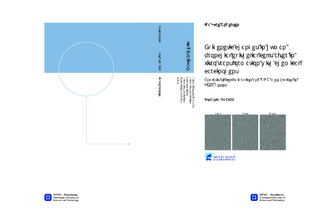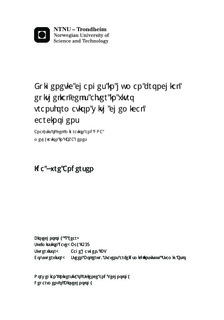| dc.description.abstract | Lung cancer is the leading cause of cancer related deaths worldwide. Cancer is caused by an accumulation of genetic and epigenetic changes that leads to alterations in gene activity and phenotype. There is emerging evidence of the epigenetic events in initiation and progression of cancer. Tobacco smoking is the major cause of lung cancer, involving numerous carcinogens. An in vitro transformation model had previously been established at STAMI, where human bronchial epithelial cells (HBECs) were exposed to tobacco smoke carcinogens (benzo[a]pyrene, cigarette smoke condensate and N-methylnitrosourea) for up to 15 weeks. Two transformed cell lines (HBEC-2KT and HBEC-12KT) were used as models to investigate molecular changes associated with transformation. The first aim of this thesis was to investigate how transformation affected cell migration. The second aim was to investigate whether DNA methylation of FOXA1 and FOXA2 genes could explain their downregulation in transformed cells relative to non-transformed cells.Two methods, the manual in vitro scratch assay and a semi-automated technique using IncuCyte ZOOM, were used to study cell migration. Both methods involve creating a wound in the cell monolayer and further measure the cells migration into the wound during a set time period. Light microscope images were acquired after 0 and 12 hours for the manual method, and on an hourly basis for 24 hours for the semi-automated method. DNA methylation studies were carried out by bisulfite treatment of DNA followed by pyrosequencing.Transformed HBEC-12KT showed decreased migration compared to their control cells (DMSO). HBEC-2KT transformed cells also showed decreased migration compared to their control cells (DMSO) when analysed by IncuCyte ZOOM. However, an increased migration was observed when transformed HBEC-2KT were analysed by in vitro scratch assay. Previous gene expression analysis of transformed cell lines showed reduced expression of E-cadherin (CDH1) and increased expression of N-cadherin (CDH2), which indicates a hallmark of EMT known as the cadherin switch. This was supported by downregulation of the FOXA1 and FOXA2 genes, which may be an essential step of EMT in cancer progression. DNA methylation levels in the FOXA1_pyro1 assay varied between 35-90 % in both transformed HBEC-2KT and their control cells (DMSO). DNA methylation levels in this assay were above 90 % in both transformed HBEC-12KT and their control cells (DMSO). DNA methylation levels in the FOXA1_pyro2 assay were above 80 % in transformed HBEC-2KT and their control cells (DMSO), and above 70 % in transformed HBEC-12KT and their control cells (DMSO). Therefore, it is difficult to draw conclusions on whether methylation of FOXA1 is related to its expression since non-transformed cells already had high methylation levels in the studied CpG sites. In addition, it might be speculated that the inspected sites are not involved in gene silencing since control cells express the gene despite high levels of methylation.Both FOXA2 assays showed overall lower DNA methylation levels than the FOXA1 assays. In the FOXA2_cpg1 assay the DNA methylation levels were below 10 % in all of the transformed cell lines (HBEC-2KT and HBEC-12KT), and also their control cells (DMSO). Methylation levels in FOXA2_TSS ranged between 0-50 % for transformed HBEC-2KT and their control cells (DMSO). The majority of the transformed HBEC-12KT cells showed DNA methylation levels between 20-50 % in the FOXA2_TSS assay. Their control cells (DMSO) also showed DNA methylation levels in the same range. Thus, downregulation of FOXA2 gene expression in transformed cell lines was in contrast to an overall low degree of DNA methylation and no outstanding changes in DNA methylation levels between non-transformed and transformed cell lines were observed.In conclusion, changes in migration between transformed and non-transformed cell lines were observed. It is, however, clear that cell migration and EMT are not directly linked in this in vitro transformation model. Based on bisulfite/pyrosequencing analyses, no outstanding changes in DNA methylation of the CpG sites studied between non-transformed and transformed cells were observed. Hence, based on the results presented in this thesis, no conclusions can be drawn to whether downregulation of FOXA1 and FOXA2 gene expression is related to DNA methylation of the regions studied. | nb_NO |

